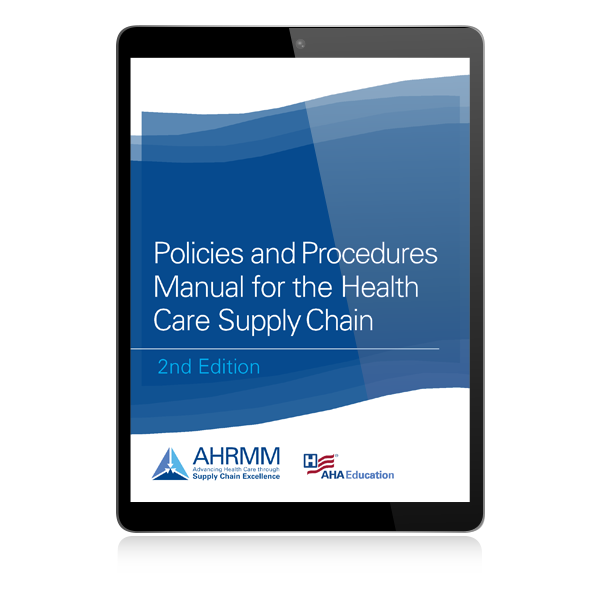Updated, Customizable and Ready to Use
The Policies and Procedures Manual for the Health Care Supply Chain, 2nd Edition is designed to help supply chain professionals create, update and tailor operational policies and procedures with ease. Featuring current best practices, customizable templates and organized chapters, it simplifies supply chain policy development while supporting team education. Flexible by design, it can be easily tailored to fit an organization’s specific needs — making it a go-to resource for efficient and informed health care supply chain management.
One-Year Subscription Price
Member: $170
Non-Member: $255

Policies and Procedures Highlights
Over 160 New Policies
Merged and updated to align with today’s leading practices.
37 Tools, Forms & Resources
Flexible format for easy customization to fit any organization’s needs.
Glossary of Terms & Definitions
Key terms and website summaries to support and educate.
Free Linen Services Policy Sample: Cleaning Scrubs at Home
This free download includes a sample policy with issuance guidelines and a home laundering program to help ensure hygiene, compliance and operational consistency. Even when linen services are outsourced, health care supply chain management oversees scrub uniform distribution.

Supply Chain Policies and Procedures Chapter Descriptions
The policies and procedures are organized to reflect the key functions and departments that make up a typical health care supply chain operation. Explore how health care supply chain management works — chapter by chapter. View Table of Contents →
The policies within this section serve as the foundation and the essence of the multiple departmental functions and the various procedures that manage the activities within the overall Administrative department. In addition, there are multiple policies that guide employees’ personal behavior and what is expected of them in the performance of their duties.
The policies within this section reflect a growing trend throughout many organizations to align activities previously performed within other departments, internally and externally, to Supply Chain. It reflects the importance of acquiring products and services in the most effective and efficient manner, while protecting the organization from a legal perspective.
In many health care organizations, there are people who believe they do or should have purchasing authority. This chapter details the appropriate policies as to how the function of Purchasing should be performed within Supply Chain. It reinforces the position that only individuals with formal purchasing authority, under organizational scrutiny and oversight, should act in a manner that commits organization funds. A structured purchasing model helps to avoid legal issues and concerns.
Inventory management is foundational to patient care. There are various methods to accomplish the function and there may be multiple methods in use throughout the organization. Nursing may use a two-bin system, PAR or auto replenishment, while the procedural areas may use RFID, automated cabinets or PAR. Attention to detail, such as accurate counts, tracking stock-outs, backorders and substitutes, and communicating this information to the clinicians, are imperative to support patient care.
The Receiving department is the primary location for the delivery of all supplies, equipment and other merchandise necessary for the operation of the organization. Receiving is responsible for verifying the accuracy of deliveries, inspecting for damage, coordinating the delivery of items to ordering departments, as well as initiating the necessary paperwork for the proper receipting and eventual payment to suppliers. Receiving is also responsible for shipping, which is the process of managing all outgoing items sent from the organization.
Although most health care organizations outsource linen/laundry services to a supplier that specializes in commercial laundering, the Supply Chain function usually oversees these operations. This section includes policies for those aspects of commercial laundry use and distribution of linen over which Supply Chain typically has responsibility or influence.
We have chosen to present an alternative policy for managing scrub clothes, as there is a significant cost savings available to those organizations that are able and willing to implement a “home laundering” program. The policy provides the basic guidelines necessary to implement and manage reduction of hospital-provided scrubs. The practice has been successfully implemented by a number of organizations with no measurable negative effect on infection prevention. The implementation of the policy will require a high level of cooperation between Supply Chain, Administration and Clinical departments.
The linen conservation policy presented in this manual should be used as a starting point to reduce the amount of linen being used by the organization. Those Supply Chain departments willing to take on this initiative have the opportunity to generate significant cost savings, although it is important to note that implementation will require the support of multiple organization departments.
Most organizations have one or more of these functions as part of Supply Chain. These functions have been combined since they often share duties and/or personnel. It is becoming rare to find an organization with a full-service print shop. However, the most cost-effective way to produce large volumes of one- or two-sided documents is the use of a high-speed duplicator. The cost per copy is normally higher, but it is easier to train an individual to run a copy machine.
Should the Central Service department (also referred to as “Central Sterile” and “Central Supply”) report to Supply Chain or not? This question continues to be debated. Although much of the distribution role has been moved to other Supply Chain sections, Central Service is still a production department and theoretically more aligned to a support department than a clinical one. It is best practice for every Supply Chain professional to maintain a level of expertise in the function. If Central Service does not report to Supply Chain now, it may in the future; therefore, Central Service is included in this manual.
These policies are written at a high level. For instance, they do not go into the detail as to how to culture a biological indicator; however, they do explain when a biological indicator is needed and what to do if one deemed positive. These policies are a good place to start for the Supply Chain professional who is unfamiliar with the function.

